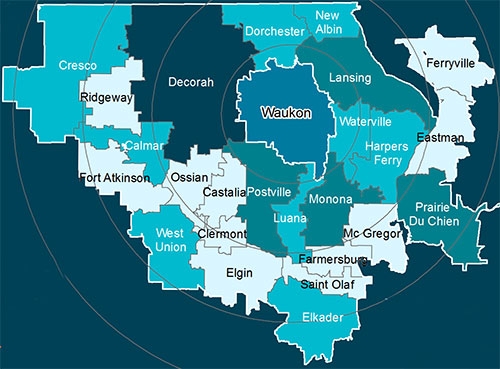You are here
Home ›Results of recent local laborshed study released by Iowa Workforce Development

by Lissa Blake
When someone is commuting to work, there are a number of considerations that affect where and how far they are willing to travel for a good job. Iowa Workforce Development (IWD) recently released the results of a laborshed study completed in a number of northeast Iowa communities, including Waukon.
A laborshed study is a “supply-side labor availability study that documents labor sources (workers) traveling to a particular employment center for work. It is based upon current commuting patterns with no restrictions by county or state lines,” explained a release from IWD.
HOW IT WORKS
Val Reinke, executive director for Allamakee County Economic Development, explained the study will assist local employers in understanding what it is that motivates individuals to take certain types of employment.
Workforce characteristics reported in the study include: employment status, a person’s likeliness to change or to accept other employment, occupation and industry, resources used during a job search, current and desired wages and benefits, age, education and distance the person is willing to travel for work, among others.
“This study can help employers see how they rate with regard to wages, benefits and other factors which people consider when seeking employment,” said Reinke. “This is an applicable tool that employers can use to see how they’re matching up.”
She further added that the information will also be helpful for school superintendents and guidance counselors to help evaluate how students are being prepared for the workforce.
LOCAL RESULTS
Keeping in mind the fact the laborshed extends beyond the city and county limits, survey results showed the estimated population, ages 18-64, of the Waukon laborshed is 37,049, and that laborshed population lies within a range surrounding Waukon of 53 miles north to south and 48 miles west to east, with 40 miles currently being the furthest distance any commuter is traveling to Waukon for employment. The number of people from that laborshed likely to accept employment in Waukon is 7,574.
The study showed 87.4 percent of workforce-age individuals are employed outside the home, while 4.2 percent are homemakers, 4.7 percent are retired and 3.7 percent are unemployed.
Of these groups, 22.9 percent of those already employed are likely to change employment, 41.2 percent of homemakers are likely to accept employment, 26.3 percent of retired individuals are likely to accept employment and 60 percent of unemployed people are likely to accept employment.
With regards to employee benefits being supplied locally, the study reveals that 83.9 percent of those employed have medical insurance, 82.4 percent provide a pension or 401K, 73.6 percent have paid vacation, 71.1 percent have paid holidays, 69.6 percent have paid time off, 69.2 percent have disability insurance, 68.5 percent have dental coverage, 67.4 percent have paid sick leave, 65.9 percent have life insurance and 59.3 percent have prescription drug coverage.
The study shows that there are 1,046 people who live in Waukon and work elsewhere, primarily Decorah or Lansing. Sixty-one percent of those commuting out earn an hourly wage, with the median wage being $19 per hour. There are 31.7 percent who earn an annual salary, and the median salary is $48,000 a year.
According to study results, the current median wage for the 6,827 employed people who would be willing to change employment for an opportunity in Waukon is $15.73 per hour or $40,000 a year. Offering $18 per hour would attract 66 percent of these people to change employment. Offering $20 per hour would attract 75 percent of these. Those who are employed are willing to commute an average of 14 miles one-way for the right employment opportunity.
WHAT DOES IT MEAN?
According to IWD Director Beth Townsend, “This data provides critical insights on the available workforce in communities and will help them and businesses develop and implement solutions to meet their workforce needs. This will also help the state have the most future-ready workforce in the nation.”
Future Ready Iowa is the state’s initiative to help close the skills gap and ensure 70 percent of the workforce has post-secondary education, training or a credential of value by 2025. According to projections, by the year 2025, 68 percent of jobs in Iowa will require education and training beyond high school.
At present, 58.4 percent of Iowa’s workforce meets this qualification.
Iowa Workforce currently is working on laborshed studies for the northern half of Iowa, with a goal of completing studies across the entire state by June of 2020.
A GREAT TOOL
Reinke said the study is a “great tool” and anyone involved with training or hiring people will find it helpful.
“If I am going to talk to a business about locating here, this helps employers to set a starting wage, look at what an experienced wage might be and more … This information is good for anyone,” she said.
To view the complete report, including a breakdown of different employment sectors, visit iowalmi.gov/laborshed-studies and type in Waukon in the search field.

